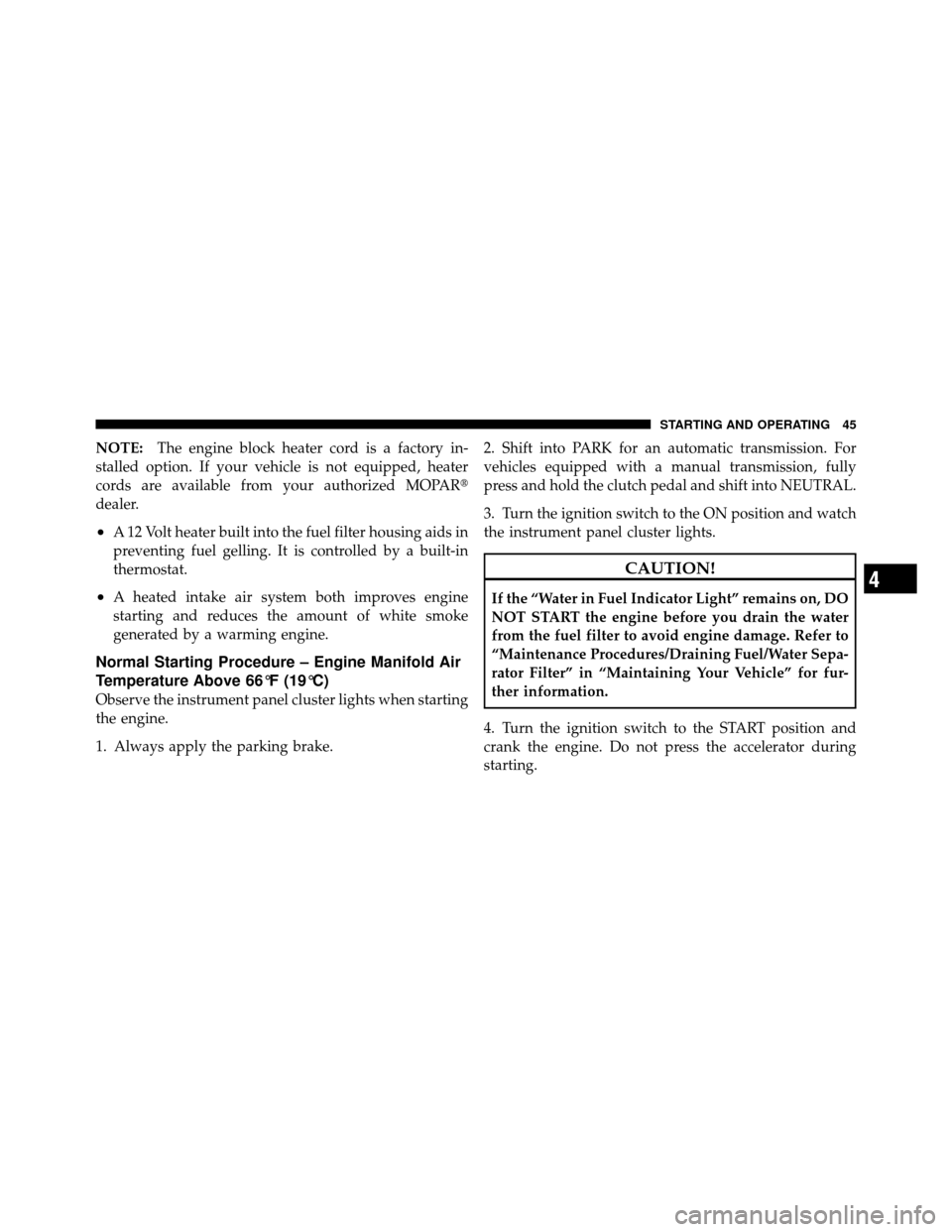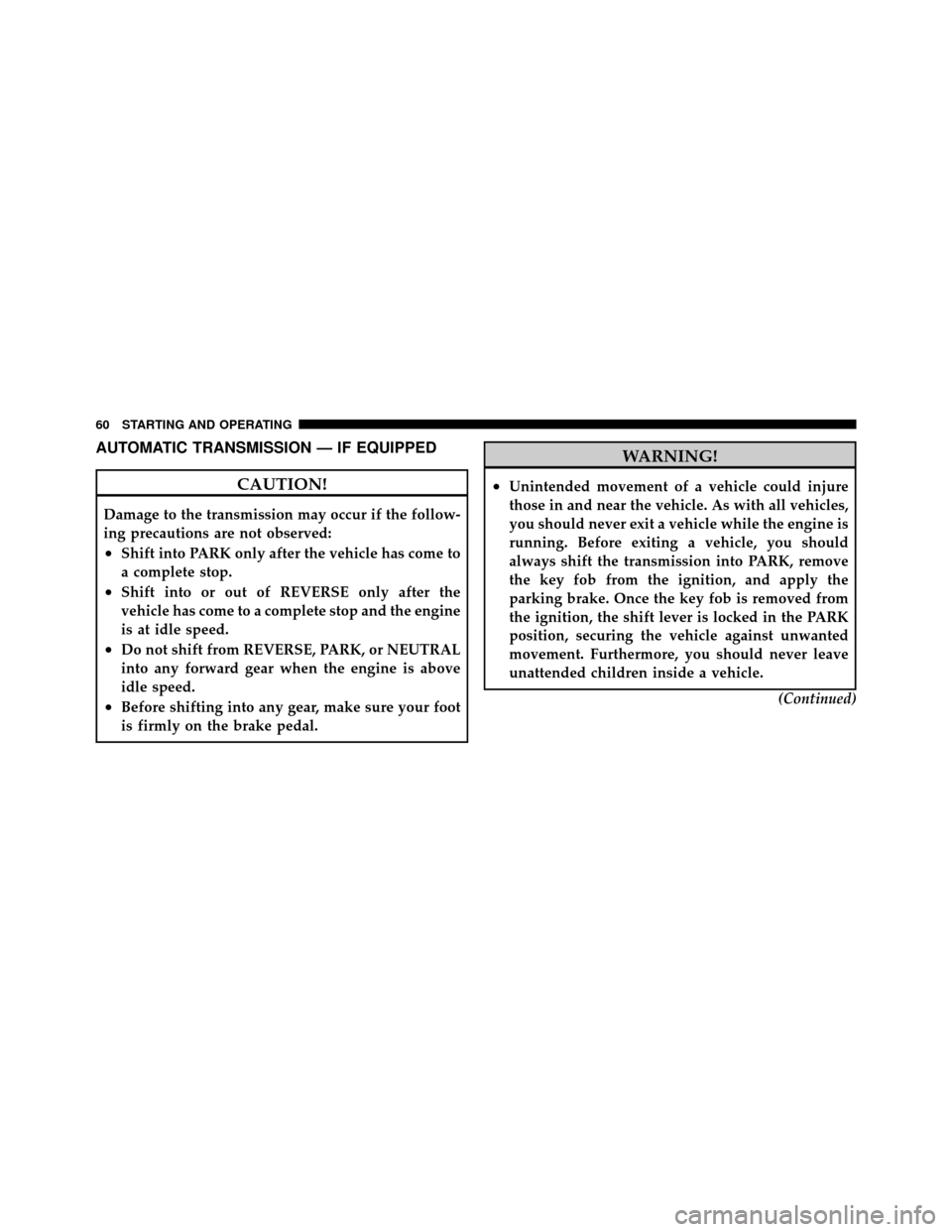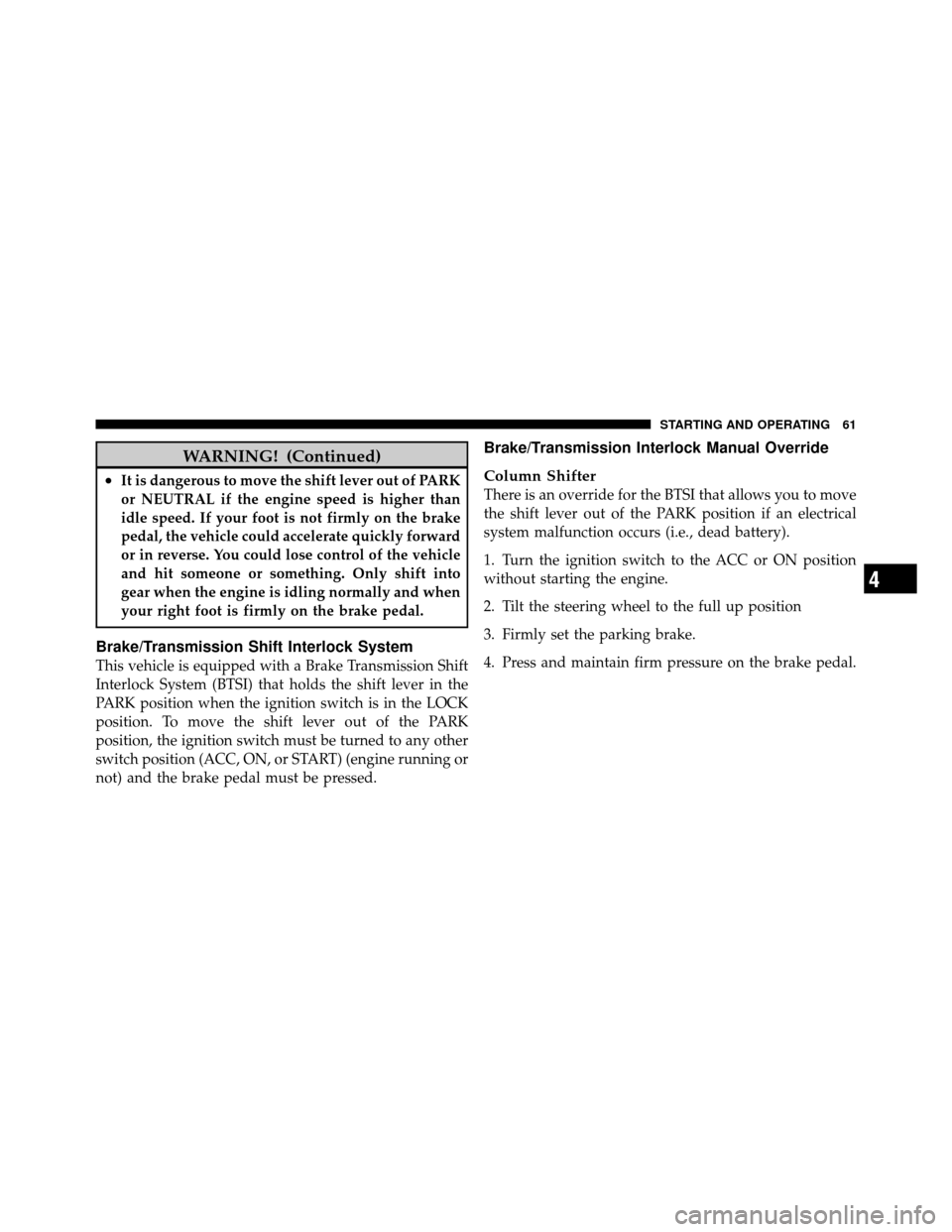Page 46 of 170

NOTE:The engine block heater cord is a factory in-
stalled option. If your vehicle is not equipped, heater
cords are available from your authorized MOPAR�
dealer.
•A 12 Volt heater built into the fuel filter housing aids in
preventing fuel gelling. It is controlled by a built-in
thermostat.
•A heated intake air system both improves engine
starting and reduces the amount of white smoke
generated by a warming engine.
Normal Starting Procedure – Engine Manifold Air
Temperature Above 66°F (19°C)
Observe the instrument panel cluster lights when starting
the engine.
1. Always apply the parking brake. 2. Shift into PARK for an automatic transmission. For
vehicles equipped with a manual transmission, fully
press and hold the clutch pedal and shift into NEUTRAL.
3. Turn the ignition switch to the ON position and watch
the instrument panel cluster lights.
CAUTION!
If the “Water in Fuel Indicator Light” remains on, DO
NOT START the engine before you drain the water
from the fuel filter to avoid engine damage. Refer to
“Maintenance Procedures/Draining Fuel/Water Sepa-
rator Filter” in “Maintaining Your Vehicle” for fur-
ther information.
4. Turn the ignition switch to the START position and
crank the engine. Do not press the accelerator during
starting.
4
STARTING AND OPERATING 45
Page 47 of 170

CAUTION!
Do not crank engine for more than 15 seconds at a
time or starter motor damage may result. Turn the
ignition switch to the OFF position and wait at least
two minutes for the starter to cool before repeating
start procedure.
5. When the engine starts, release the key fob.
6. Check to see that there is oil pressure.
7. Release the parking brake.
Starting Procedure – Engine Manifold Air
Temperature 0°F to 66°F (–18°C to 19°C)
NOTE: The temperature displayed in the Electronic
Vehicle Information Center (EVIC) does not necessarily
reflect the engine manifold air temperature. Refer to “Electronic Vehicle Information Center (EVIC)” in “Un-
derstanding Your Instrument Panel” for further informa-
tion. When engine temperatures fall below 66°F (19°C)
the “Wait To Start Light” will remain on indicating the
intake manifold heater system is active.
Follow the steps in the “Normal Starting” procedure
except:
1. The “Wait To Start Light” will remain on for a period
of time (length of time depends on engine temperature).
CAUTION!
If the “Water in Fuel Indicator Light” remains on, DO
NOT START engine before you drain the water from
the fuel filter to avoid engine damage. Refer to
“Maintenance Procedures/Draining Fuel/Water Sepa-
rator Filter” in “Maintaining Your Vehicle” for fur-
ther information.
46 STARTING AND OPERATING
Page 48 of 170

2. After the “Wait To Start Light” goes off, turn the
ignition switch to the START position. Do not press the
accelerator during starting.
CAUTION!
Do not crank engine for more than 15 seconds at a
time or starter motor damage may result. Turn the
ignition switch to the OFF position and wait at least
two minutes for the starter to cool before repeating
start procedure.
3. After engine start-up, check to see that there is oil
pressure.
4. Allow the engine to idle about three minutes until the
manifold heaters have completed the post-heat cycle.
5. Release the parking brake and drive. NOTE:
•Engine idle speed will automatically increase to 1,000
RPM at low coolant temperatures to improve engine
warm-up.
•If the engine stalls, or if the ignition switch is left ON
for more than two minutes after the “Wait To Start
Light” goes out, reset the grid heaters by turning the
ignition switch to the OFF position for at least five
seconds and then back ON. Repeat steps 1 through 5 of
“Starting Procedure – Engine Manifold Air Tempera-
ture Below 66°F (19°C).”
Starting Procedure – Engine Manifold Air
Temperature Below 0°F (-18°C)
In extremely cold weather below 0°F (-18°C) it may be
beneficial to cycle the manifold heaters twice before
attempting to start the engine. This can be accomplished
by turning the ignition OFF for at least five seconds and
then back ON after the “Wait To Start Light” has turned
4
STARTING AND OPERATING 47
Page 49 of 170

off, but before the engine is started. However, excessive
cycling of the manifold heaters will result in damage to
the heater elements or reduced battery voltage.
NOTE: If multiple pre-heat cycles are used before
starting, additional engine run time may be required to
maintain battery state of charge at a satisfactory level.
1. If the engine stalls after the initial start, the ignition
must be turned to the OFF position for at least five
seconds and then to the ON position to recycle the
manifold heaters.
NOTE:Excessive white smoke and poor engine perfor-
mance will result if manifold heaters are not recycled.
2. Heat generated by the manifold heaters dissipates
rapidly in a cold engine. If more than two minutes pass
between the time the “Wait To Start Light” turns off and the engine is started, recycle the manifold heaters by
turning the ignition switch to the OFF position for at least
five seconds and then back ON.
3. If the vehicle is driven and vehicle speed exceeds
19 mph (31 km/h) before the manifold heater post-heat
(after start) cycle is complete, the manifold heaters will
shut off.
4. If the engine is started before the “Wait To Start Light”
turns off, the preheat cycle will turn off.
5. If the engine is cranked for more than 10 seconds, the
post-heat cycle will turn off.
NOTE:
•Engine idle speed will automatically increase to 1, 000
RPM at low coolant temperatures to improve engine
warm-up.
48 STARTING AND OPERATING
Page 61 of 170

AUTOMATIC TRANSMISSION — IF EQUIPPED
CAUTION!
Damage to the transmission may occur if the follow-
ing precautions are not observed:
•Shift into PARK only after the vehicle has come to
a complete stop.
•Shift into or out of REVERSE only after the
vehicle has come to a complete stop and the engine
is at idle speed.
•Do not shift from REVERSE, PARK, or NEUTRAL
into any forward gear when the engine is above
idle speed.
•Before shifting into any gear, make sure your foot
is firmly on the brake pedal.
WARNING!
•Unintended movement of a vehicle could injure
those in and near the vehicle. As with all vehicles,
you should never exit a vehicle while the engine is
running. Before exiting a vehicle, you should
always shift the transmission into PARK, remove
the key fob from the ignition, and apply the
parking brake. Once the key fob is removed from
the ignition, the shift lever is locked in the PARK
position, securing the vehicle against unwanted
movement. Furthermore, you should never leave
unattended children inside a vehicle.(Continued)
60 STARTING AND OPERATING
Page 62 of 170

WARNING! (Continued)
•It is dangerous to move the shift lever out of PARK
or NEUTRAL if the engine speed is higher than
idle speed. If your foot is not firmly on the brake
pedal, the vehicle could accelerate quickly forward
or in reverse. You could lose control of the vehicle
and hit someone or something. Only shift into
gear when the engine is idling normally and when
your right foot is firmly on the brake pedal.
Brake/Transmission Shift Interlock System
This vehicle is equipped with a Brake Transmission Shift
Interlock System (BTSI) that holds the shift lever in the
PARK position when the ignition switch is in the LOCK
position. To move the shift lever out of the PARK
position, the ignition switch must be turned to any other
switch position (ACC, ON, or START) (engine running or
not) and the brake pedal must be pressed.
Brake/Transmission Interlock Manual Override
Column Shifter
There is an override for the BTSI that allows you to move
the shift lever out of the PARK position if an electrical
system malfunction occurs (i.e., dead battery).
1. Turn the ignition switch to the ACC or ON position
without starting the engine.
2. Tilt the steering wheel to the full up position
3. Firmly set the parking brake.
4. Press and maintain firm pressure on the brake pedal.
4
STARTING AND OPERATING 61
Page 76 of 170

Shifting
Truck models with manual transmission are equipped
with a clutch interlocking ignition system. The clutch
pedal must be fully pressed to start the vehicle.Fully press the clutch pedal before shifting gears. As you
release the clutch pedal, lightly press the accelerator
pedal.
This transmission has a “creeper” first gear (L=Low)
which should be used to start from a standing position
when carrying a payload or towing a trailer. Damage to
the clutch can result from starting in second or third gear
with a loaded vehicle. An unloaded vehicle may be
launched in second gear. Use each gear in numerical
order – do not skip a gear.
You should use first gear when starting from a standing
position if under heavy load or when pulling a trailer.Recommended Vehicle Shift Speeds
To utilize your manual transmission efficiently for both
fuel economy and performance, it should be upshifted as
listed in recommended shift speed chart. Shift at the
Shift Pattern
4
STARTING AND OPERATING 75
Page 82 of 170

ENGINE RUNAWAY
WARNING!
In case of engine runaway due to flammable fumes
from gasoline spills or turbocharger oil leaks being
sucked into the engine, do the following to help
avoid personal injury and/or vehicle damage:
1. Turn the ignition switch to the OFF position.
2. Using a CO
2or dry chemical type fire extin-
guisher, direct the spray from the fire extinguisher
into the grille on the passenger side so that the spray
enters the engine air intake.
The inlet for the engine air intake is located behind
the passenger side headlamp and receives air
through the grille.
FUEL REQUIREMENTS
Use good quality diesel fuel from a reputable supplier in
your vehicle. Federal law requires that you must fuel this
vehicle with Ultra Low Sulfur Highway Diesel fuel (15
ppm Sulfur maximum) and prohibits the use of Low
Sulfur Highway Diesel fuel (500 ppm Sulfur maximum)
to avoid damage to the emissions control system. For
most year-round service, No. 2 diesel fuel meeting ASTM
specification D-975 Grade S15 will provide good perfor-
mance. If the vehicle is exposed to extreme cold (below
20°F or -7°C), or is required to operate at colder-than-
normal conditions for prolonged periods, use climatized
No. 2 diesel fuel or dilute the No. 2 diesel fuel with 50%
No. 1 diesel fuel. This will provide better protection from
fuel gelling or wax-plugging of the fuel filters.
4
STARTING AND OPERATING 81